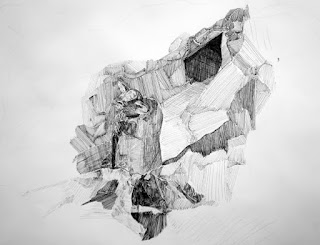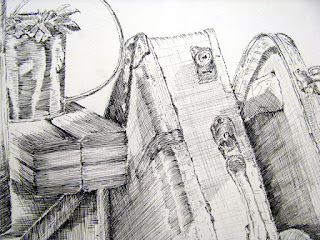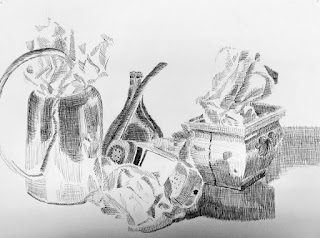You will be creating hatched value studies in which you will need to accurately record areas of value on your subject, by building cross-hatched lines accordingly. You will be using your fine-tipped Micron ink pens, and it is quite possible that you may use its ink supply up on this drawing, and may need to purchase another. If your pen does begin to run out, save it-- for you may use the dwindling ink supply to render some areas of softer value. Rather than creating heavy outlines around your subjects, build and define the edges using value, in a way that the volume or mass of your forms is made clear by its relationship to light. You will be making this drawing on a sheet of your bristol board.
Your next investigation of value will involve the use of cross-hatching. That is, creating a network of lines in which they cross over one another in varying degrees of density in order to express value (the perception of the relative lightness or darkness on the surface of your model, caused by lighting conditions).
- Create a small arrangement with at least two glass vessels (vase, bottle, bowl, or drinking glass), a crumpled sheet of white paper, and a fruit or vegetable that is sliced open and arranged to show its interior.
- Light it carefully with a single light source aimed from one direction so as to create shadows.
- This project will be finished over the course of two weeks, so you should be spending a total of eight hours on it.
- Create a series of compositional thumbnails.
- Lightly create a sketch of the composition of your choice on a sheet of bristol board.
- Do not outline your subjects with heavy ink lines-- rather, the edges of your objects will be defined by value, by degrees of lightness and darkness. Remember to carefully construct value-- paying attention to the parts of value as discussed in class, and reflecting that understanding with a varying density in your cross-hatched lines.
* Continue to remember our discussions on composition-- Avoid large empty, open areas, and bring your subject forward so that you can "get into it." Also, avoid uncomfortable squeezing of space, by having your objects resting on the edge of your picture plane-- either give them more space, or crop them. As always-- correct perspective and proportion is essential.
DRAWING FOR NON-MAJORS: DUE THURSDAY NOVEMBER 10.










